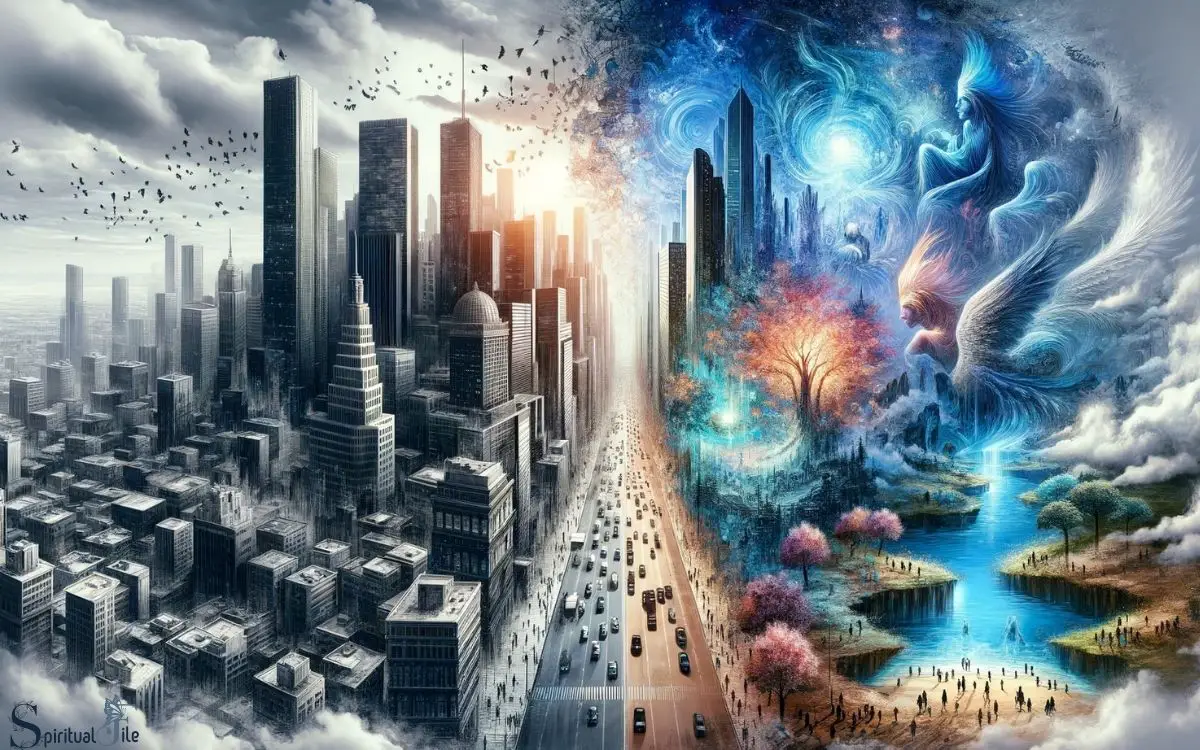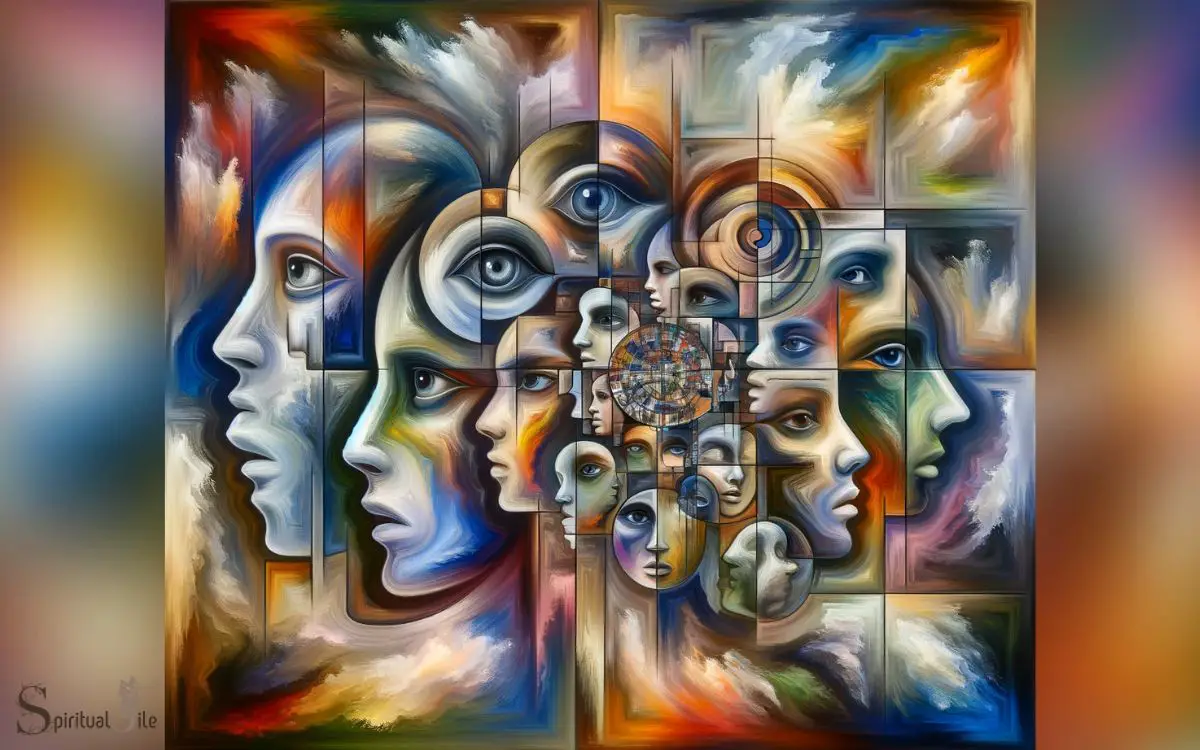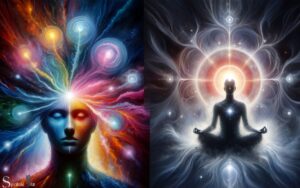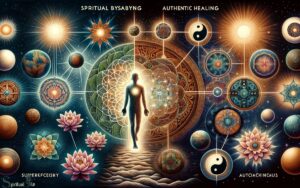Physical World Vs Spiritual World: Faith!
The physical world and the spiritual world are two fundamental aspects of human existence that influence our lives in profound ways.
The physical world is tangible and encompasses all that we can see, touch, and measure, while the spiritual world is intangible and relates to the soul, faith, and higher consciousness.
Both realms coexist and often intersect, affecting how individuals perceive reality and seek purpose in life.
The concept of the physical world is straightforward—it is the material realm that includes our bodies, the environment, and all physical phenomena.
The spiritual world, on the other hand, is more abstract and can be challenging to define since it involves personal beliefs, emotions, and the unseen forces that shape our values and motivations.
Physical World:
- Tangibility: Can be observed through the five senses.
- Science: Governed by natural laws and scientific principles.
- Interaction: Includes all physical interaction and observable phenomena.
- Spiritual World:
- Intangibility: Cannot be measured or observed in the same way as the physical world.
- Belief Systems: Encompasses religion, spirituality, and individual faith.
- Influence: Shapes morals, ethics, and the deeper meaning individuals seek in life.
For example, a person might find physical satisfaction in acquiring a new home (physical world), but may find spiritual fulfillment in the sense of community and belonging it brings (spiritual world.

Key Takeaway
5 Aspects: Physical World Vs Spiritual World
| Aspect | Physical World | Spiritual World |
|---|---|---|
| Nature | Tangible, material realm | Intangible, metaphysical |
| Perception | Senses and empirical data | Inner intuition, faith |
| Reality | Observable, concrete | Subjective, abstract |
| Boundaries | Finite and measurable | Infinite and boundless |
| Purpose | Survival, material goals | Meaning, transcendence |
The Nature of Reality

The nature of reality in the physical world is often understood through empirical observation and scientific inquiry. It involves the exploration of the fundamental principles governing the universe, including the properties of matter, energy, space, and time.
Through scientific methods such as experimentation, observation, and analysis, researchers seek to uncover the underlying laws that govern our physical reality.
This empirical approach has led to remarkable advancements in our understanding of the natural world, enabling the development of technologies and the formulation of theories that have transformed human society.
Perceptions and Interpretations

As we explore the interaction between the physical and spiritual worlds, it is essential to consider the role of perceptions and interpretations.
Reality and belief systems play a significant part in shaping our understanding of the world around us, and it is crucial to recognize the distinction between subjective and objective reality.
Reality and Belief Systems
In the context of the physical world vs spiritual world, the perception and interpretation of reality are shaped by individual belief systems.
Our belief systems influence how we perceive and interpret the world around us, affecting our understanding of what is real and what is not.
These belief systems are often rooted in cultural, religious, or personal experiences, and they can significantly impact our understanding of reality.
To illustrate the influence of belief systems on reality, consider the following table:
| Perception and Interpretation | Influence on Reality |
|---|---|
| Cultural beliefs | Shapes worldview |
| Religious teachings | Defines moral framework |
| Personal experiences | Shapes individual reality |
| Scientific knowledge | Shapes understanding of physical world |
| Philosophical perspectives | Shapes interpretation of existence |
Understanding the impact of belief systems on reality is crucial in comprehending the differences in how individuals perceive and interpret the physical and spiritual worlds.
Subjective Vs Objective Reality
Perceptions and interpretations of reality can vary greatly among individuals due to their subjective understanding shaped by belief systems.
Subjective reality is influenced by personal experiences, emotions, and cultural background, leading to a unique lens through which individuals perceive the world.
On the other hand, objective reality is independent of individual perspectives and exists outside of personal biases or interpretations. It is rooted in empirical evidence and facts that can be verified and agreed upon universally.
Understanding the interplay between subjective and objective reality is essential in navigating differences in perspectives and interpretations.
While subjective reality offers a personalized and emotional connection to the world, acknowledging objective reality helps in establishing common ground and fostering mutual understanding.
Striking a balance between the two is crucial for a comprehensive and inclusive worldview.
Influence on Human Experience

The influence of the physical and spiritual worlds on human experience is profound, shaping our perceptions and interpretations of the world around us.
The impact on daily life and the connection to a higher purpose are pivotal aspects that warrant exploration.
Understanding how these two realms intersect and interact can provide valuable insights into the complexities of human existence.
Impact on Daily Life
The influence of the spiritual world on human experience is profound and pervasive, shaping attitudes, behaviors, and perspectives.
In daily life, this influence manifests in various ways:
- Guidance: Spiritual beliefs often provide guidance and moral compass for decision-making.
- Well-being: Spiritual practices such as meditation and prayer promote emotional and mental well-being.
- Community: Participation in spiritual communities fosters a sense of belonging and support.
- Purpose: The spiritual world often gives individuals a sense of purpose and meaning in their daily activities.
These aspects of the spiritual world impact daily life in profound ways, influencing how individuals navigate the challenges and joys of their existence.
Understanding this impact can lead to a deeper appreciation of the interconnectedness of the physical and spiritual realms. This interconnectedness forms the basis for exploring the concept of connection to a higher purpose.
Connection to Higher Purpose
Human experience is significantly influenced by the spiritual world’s connection to a higher purpose. This connection provides individuals with a sense of meaning and direction, shaping their values, beliefs, and choices.
Understanding the influence of the spiritual world on human experience can be facilitated through the following comparison:
| Physical World | Spiritual World |
|---|---|
| Material existence | Eternal existence |
| Limited perspective | Expanded awareness |
| Temporary fulfillment | Lasting fulfillment |
| Individual identity | Oneness with all |
| Linear time | Non-linear time |
The spiritual world’s connection to a higher purpose not only enriches human experience but also fosters a deeper understanding of existence.
This understanding sets the stage for exploring the interconnectedness and balance between the physical and spiritual realms.
Interconnectedness and Balance

Interconnectedness and balance are integral aspects of both the physical and spiritual worlds. They encompass a harmony that sustains the universe and all existence within it.
In understanding this concept, consider the following:
- Ecosystems: The delicate balance of ecosystems demonstrates how interconnectedness ensures the survival of various species.
- Yin and Yang: This symbol of balance in Eastern philosophy represents the interconnectedness of opposite forces.
- Human Relationships: Interconnectedness is evident in how our actions and emotions affect those around us, highlighting the balance required for harmonious coexistence.
- Universal Energy: The spiritual world emphasizes the interconnectedness of all beings through the universal energy that flows through everything.
Recognizing and respecting interconnectedness and balance fosters a deeper understanding of the intricate relationships that sustain both the physical and spiritual realms.
Manifestation and Transcendence

In understanding the interconnectedness and balance established in the previous subtopic, the concept of manifestation and transcendence in both the physical and spiritual worlds requires contemplation and exploration.
Manifestation encompasses the idea that thoughts and beliefs have the power to shape our reality in the physical world. It suggests that our actions and intentions hold the potential to bring about tangible outcomes.
Transcendence, on the other hand, delves into the spiritual realm, focusing on the pursuit of higher states of consciousness and existence beyond the material world.
The interconnectedness between manifestation and transcendence lies in the recognition of the influence of our spiritual nature on our physical experiences.
Understanding this dynamic relationship allows for a deeper comprehension of the holistic nature of existence. This understanding serves as a gateway to seeking meaning and purpose in both realms.
Seeking Meaning and Purpose

The quest for meaning and purpose is integral to both the physical and spiritual realms. It is a fundamental aspect of human existence and drives individuals to seek understanding and fulfillment in their lives.
In this pursuit, people often turn to both the physical and spiritual worlds for guidance and enlightenment.
When seeking meaning and purpose, individuals may engage in various practices and activities such as:
- Reflection and self-examination
- Seeking wisdom from spiritual teachings and texts
- Engaging in acts of service and compassion
- Connecting with a higher power or universal energy
These endeavors help individuals to explore the depths of their existence and find significance in their lives, bridging the gap between the physical and spiritual realms in the pursuit of meaning and purpose.
Physical Life vs Spiritual Life
Physical life and spiritual life are two distinct aspects of human existence that can coexist and interact in various ways. Here’s a breakdown of each:
Physical Life:
- Physical life refers to the tangible, material aspect of human existence. It encompasses everything related to our bodies, the physical world, and the sensory experiences we have.
- It includes activities such as eating, sleeping, working, exercising, socializing, and engaging in hobbies or leisure pursuits.
- Physical life is closely tied to the biological and physiological aspects of human beings, such as health, physical well-being, and the pursuit of material comfort and security.
- It is often associated with our interactions with the external, observable world and the pursuit of worldly goals and pleasures.
Spiritual Life:
- Spiritual life refers to the inner, intangible, and non-material aspect of human existence. It encompasses one’s beliefs, values, morals, ethics, and the search for meaning and purpose in life.
- It involves exploring questions about the nature of existence, the meaning of life, and the connection to something greater than oneself, such as a higher power, the universe, or a transcendent reality.
- Spiritual life often includes practices like meditation, prayer, mindfulness, self-reflection, and the pursuit of inner peace, wisdom, and personal growth.
- It can be deeply personal and subjective, varying greatly from person to person based on their religious or philosophical beliefs, cultural background, and life experiences.
It’s important to note that these two aspects of life are not necessarily mutually exclusive. Many people integrate their physical and spiritual lives in various ways.
For some, religion or spirituality plays a significant role in guiding their actions and decisions in the physical world, while for others, spiritual pursuits are more personal and separate from their daily activities.
– How Does the Concept of Right Side Vs Left Side Spiritualism Relate to Faith in the Physical and Spiritual Worlds?
The concept of right side vs left side spiritualism presents an interesting angle to the faith in the physical and spiritual worlds. In the spiritual universe comparison, the right side symbolizes the rational, logical, and conscious aspects, while the left side embodies intuition, emotions, and the subconscious. This dichotomy offers a unique perspective on faith and spirituality.
Frequently Asked Questions
Can the Physical World and Spiritual World Coexist Peacefully?
The coexistence of the physical and spiritual worlds requires understanding, respect, and open-mindedness.
As we navigate this complex question, it’s essential to consider various perspectives and seek common ground to foster peaceful coexistence.
How Do Our Perceptions and Interpretations of the World Affect Our Spiritual Experiences?
Our perceptions and interpretations of the world shape our spiritual experiences profoundly.
When we approach life with openness and mindfulness, we can cultivate deeper connections with the spiritual realm, leading to greater understanding and growth.
What Influence Does the Spiritual World Have on Human Emotions and Behavior?
The influence of the spiritual world on human emotions and behavior is a complex interplay of belief systems, values, and existential perspectives.
Understanding this influence requires an exploration of spirituality’s impact on individual and collective consciousness.
Is There a Balance Between the Interconnectedness of the Physical and Spiritual Worlds?
The balance between the interconnectedness of the physical and spiritual worlds is a complex and often debated topic.
It requires careful consideration of various perspectives and belief systems to gain a comprehensive understanding.
How Can One Manifest Spiritual Experiences and Transcend the Limitations of the Physical World?
To manifest spiritual experiences and transcend physical limitations, one must cultivate mindfulness, meditation, and self-awareness.
These practices enable a deeper connection with the inner self, leading to spiritual growth and a greater understanding of existence.
Conclusion
The physical world and spiritual world exist in a symbiotic relationship, like two dancers gracefully moving in harmony. Their interconnectedness shapes human experience and influences perceptions and interpretations.
Seeking meaning and purpose involves understanding the balance and manifestation of these worlds. The nature of reality transcends the limitations of the physical, leading to a deeper understanding of existen






